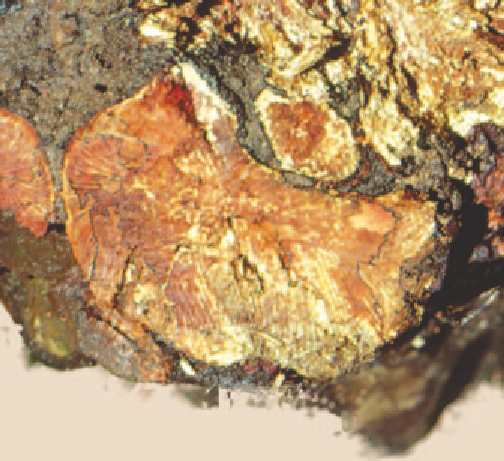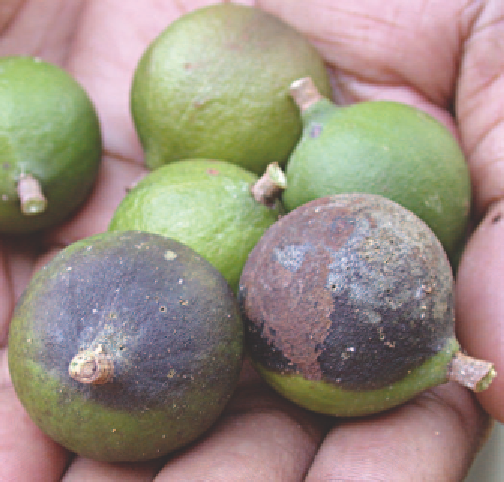Agriculture Reference
In-Depth Information
Monitor disease incidence from December and kernel
maturity from February (main season crop). Prepare for
harvesting if husk spot is evident by mid January.
•
forest species. The wounding of trunk and primary roots
through wind damage or by machines may encourage
infection under moist conditions.
Importance
This is a minor disease occurring in macadamia-growing
areas where annual rainfall exceeds 1200 mm. The disease
has not been found in drier areas.
ROOT DECAY
■
Cause
The fungus
Kretzschmaria cetrarioides
.
Management
•
Symptoms
This disease is a fungal root rot of mature trees, which
decline over several years and die. The above-ground
symptoms of leaf drop - sparse canopy and twig dieback -
are similar to those of phytophthora trunk canker.
The decay of major structural roots, which extends
into the base of the trunk, is characteristic. Diseased
primary roots have pockets of white wood decay bounded
by black zone lines visible when the bark is removed or
when the root is sectioned transversely or longitudinally.
The black-line pattern is seen in the heartwood of the
trunk also. Clusters of small, fruiting bodies develop after
several months on exposed root and butt sections in dark,
brittle, fungal encrustations up to 5 mm thick.
Remove stumps and roots of native vegetation during
orchard-site preparation.
Avoid wounding trees during harvesting and when
slashing for weed control.
•
Provide windbreaks for plantation protection.
•
PHOMOPSIS HUSK ROT AND CANKER
■
Cause
The fungus
Phomopsis
sp.
Symptoms
Phomopsis husk rot usually occurs in association with husk
splitting along the suture line; nut borer damage; hail or
wind rub; or other injuries to the green husk. Stem-end
infection of the husk via the pedicel or f flower stalk can
also occur. The rapid spread of the
Phomopsis
fungus
discolours the entire husk. The lesions lack a chlorotic stage,
Source of infection and spread
The fungus survives on diseased roots and stumps.
Ascospores of the fungus are discharged after rain from
the dark fruiting bodies described above. The host range
of the fungus is not known, but may include several woody
Fig 11.4 Macadamia root decay caused by the fungus
Kretzschmaria
cetrarioides
. Areas of decayed wood are limited by black lines.
Fig 11.5 Phomopsis husk rot in macadamia kernels.














